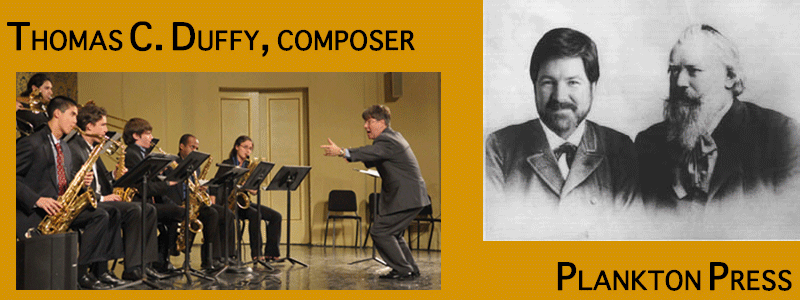ABSTRACT: AESTHETICS: A MATTER OF TASTES
Thomas C. Duffy, DMA, Yale University
Presented to the College Band Directors National Association Conference
February 22, 1997, Athens, GA
Critics are credited with having intrinsic knowledge of "goodness/ beauty," with which they make pronouncements on art, often in defiance of popular opinion and all apparent evidence. The intangibility of this "divine inspiration" gives rise to insecurity and self-doubt when "non-critics" are asked to evaluate the "goodness" of musical compositions. This study traces the attribution of goodness and beauty, from the ancient philosophers to Schelling. Development of aesthetic taste in music is then compared with the development of "taste" for food, which involves primarily the senses of taste and smell.
Criteria for aesthetic goodness are the results of social and biological interactions. The classical philosophers attribute goodness/ beauty as follows: PlatoÑdeterminants for goodness reside with metaphysical essences or templates (perfection), against which empirical art measures as deficient; AristotleÑdeterminants for goodness reside in the natural world with all of its deficienciesÑart can correct the deficiencies of nature; St. AugustineÑgoodness resides in the province of the divine; the goodness of empirical art is measured by its proximity to the divine, with lesser-corporeal pursuits (listening to music as opposed to viewing a painting) having more value than artifacts. Secular humanism focused on the empirical world and transcendental realist Schelling proposed that goodness be determined by the individual ego. At this point, physiology becomes important, as biological systems could serve as common denominators for humans in the determination of beauty and goodness. Is the human physiology hardwired to be predisposed to any sounds and flavors?
The domains of "taste" for food and aesthetics have parallel attributes. Humans develop preference for foods primarily on taste (i.e., perception of salt, sugar, sour, bitter) and smell (i.e., perception of thousands of individual compounds that allow exact identification of a food). Very little of preference for foods is innate; humans are born only with an innate preference for sweet and a disgust for bitter. All other preferences and aversions are conditioned; positive conditioning produces preference, negative conditioning produces aversion.
Humans can even override innate preferences through conditioning (i.e., a developed preference for the bitterness of coffee as conditioned by the positive attributes of caffeine). As hardwiring predisposes humans to prefer sweet and reject bitter, it also is responsible for human preference for consonance over dissonance (Kagan, 1997) and medium over extreme amplitude from the world of aural stimuli. All other preferences or aversions are the results of learning. Through repeated exposures, the body creates complex templates from combinations of fundamental perceptions. In both taste domains, social, intellectual and cognitive factors play important roles in the development of preference and aversion.
Given, then, that every human can determine what is good, why is there such insecurity about doing just that" Tastes change over time, as evidenced by the musical reviews printed in The Lexicon of Musical Invective (Slonimsky). HegelÕs Dialectic outlines a theory for social (aesthetic) evolution, one which explains the antipathy with which new masterpieces were (and are) received. How then shall we decide what makes a composition "good"" Repeated selection is a reasonably realistic measure of one standard of preference. Societal preferences for certain flavors could be identified by tallying which food flavors were most selected for consumption. As well, one could identify musical preferences by tallying which compositions were most selected for performance. This presentation concluded with a listing of compositions that were performed by All-state bands over the past twenty years (these ensembles perform with such competence as to reduce the number of non-qualitative reasons for programming). Post facto, these compositions embody what, in practice, the profession held to be "good."

